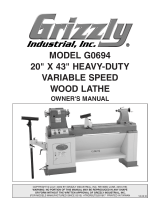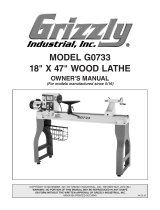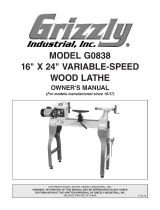Page is loading ...

COPYRIGHT © JULY, 2011 BY GRIZZLY INDUSTRIAL, INC. MAY, 2013 (TR)
WARNING: NO PORTION OF THIS MANUAL MAY BE REPRODUCED IN ANY SHAPE
OR FORM WITHOUT THE WRITTEN APPROVAL OF GRIZZLY INDUSTRIAL, INC.
#TR14268 PRINTED IN CHINA
Specifications
• Three-number combination lock.
• Storage slots for eight rifles or shotguns.
• Rated at 1700° F for 30 minutes.
• Three interior shelves, two adjustable.
• Overall dimensions: 20
3
⁄4"W x 15
3
⁄4"D x 59"H.
• Shipping weight: 273 lbs.
Combination
Model H7811 Large Gun Safe.
Combination
Dial
To open the safe:
1. Rotate the combination dial clockwise at least
four full revolutions, then stop on the first
combination number.
2. Rotate the dial counterclockwise past the
second combination number once, then stop
on this number the second time.
3. Turn the dial clockwise and stop on the last
combination number.
4. Turn the handle and pull the door open.
NOTICE
Keep these instructions with the included
combination in a separate secure location
from the safe. Misplacing or forgetting the
combination will render the safe unusable.
Grizzly cannot replace lost combinations.
Door Handle
For questions or help with this product contact Tech Support at (570) 546-9663 or techsupport@grizzly.com
MODEL H7811
FIRE RESISTANT
GUN SAFE
INSTRUCTIONS
Maintenance
Clean the surfaces of the safe with a slightly damp
cloth. If the hinges should develop a squeak,
apply one or two drops of light machine oil to the
hinge contact points.
To lock your safe:
1. Close the door and turn the handle to engage
the lock.
2. Rotate the combination dial at least two full
revolutions in either direction to lock the door
handle.
• Never allow anyone to be locked inside
safe—suffocation may occur!
• Do not climb or stand on safe—it could
tip and cause serious personal injury.
• Anchor safe to floor (see back page) to
prevent tipping or theft.

-2-
H7811 Gun Safe
Bolting to Wood Floors
Lag screws and flat washers are typically used to
bolt safes to wood floors (or floors with a wood
sub-floor).
Safe
Floor
Lag Screw
Flat Washer
Installation of lag screws works best if holes are
pre-drilled to accommodate the lag screws. A
standard handheld power drill with the appropri-
ate-sized wood drill bit is required to complete the
job.
To ensure strong and successful anchoring to
wood:
• Pre-drill holes at the correct size for the lag
screws. The correct pre-drill size is always
smaller than the lag screw size. (For exam-
ple, a
7
⁄32" bit is used to pre-drill holes for a
3
⁄8"
lag screw.)
• Use at least a 2" long lag screw.
• For additional strength, fasten at least two of
the screws into floor joists.
Verify that floor area to be drilled is free
of electrical wires, gas lines, water lines,
sewer lines, etc. Drilling into these items
unintentionally can cause electric shock,
fire, or property damage.
Anchoring to Concrete Floors
Lag shield anchors are generally recommended
because they mount flush with the floor and allow
the safe to be bolted down with a lag screw and
flat washer.
Safe
Concrete
Lag Screw
Lag Shield Anchor
Flat Washer
Drilled Hole
Installation of lag shield anchors requires you to
drill holes into the concrete. Drilling into concrete
properly requires a hammer drill with an appropri-
ate sized concrete drill bit.
To ensure strong and successful anchoring to
concrete:
• Drill holes in one pass and avoid raising the
bit up and down to clear the dust, which may
cause the holes to be come slightly over-
sized.
• Drill holes
1
⁄2"-1" deeper than the length of the
lag shield to allow room for the bottom of the
screw and any remaining dust.
• Vacuum dust from holes before installing lag
shields.
Anchoring Your Safe
Anchoring the safe to the floor reduces the risk
of tipping and makes theft of the entire safe
extremely difficult. The safe can be anchored to
any surface, but wood and concrete are the most
common.
Before anchoring the safe, all shelves and wall
boards must be removed to expose the anchoring
holes in the bottom of the safe. Holes can gener-
ally be drilled with the safe in-place, depending on
the size and shape of the drill used.
/






